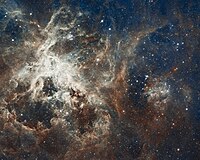Astronomers discover smallest known star
Friday, July 14, 2017
On Wednesday, astronomers at the University of Cambridge in England announced the discovery of a dwarf star, known as EBLM J0555-57Ab, which is slightly bigger than Saturn and smaller than Jupiter. It was found using data from an array of automated telescopes called the Wide Angle Search for Planets (WASP). The study was published in the journal Astronomy & Astrophysics.
The star belongs to the Milky Way galaxy and is approximately 600 light years away from Earth. Its mean radius is about 80 percent the size of the largest planet in the Solar System, Jupiter, but despite its small size it is very dense. Its mass is almost 85±4 times the gas giant, the study said. The star's surface gravitational pull is about eleven times stronger than the Sun's — 300 times the strength by which the Earth attracts matter. It is part of a binary star system, meaning it moves around the galaxy with another star, both orbiting around the same central point. However, it stays so close to its companion star, that it takes about 7.8 days to orbit around the pair's shared centre. The distance between the two stars is less than between Mercury and the Sun, and about eight percent of an astronomical unit, in stark contrast to the 100–1000 astronomical units that typically separates two stars in such a system.
It was discovered by the method called "astronomical transit". This method is used to discover planets or satellites, and the astronomers initially thought it was merely an exoplanet. During a planet's revolution, when it crosses its parent star, there is a dip in the brightness of the light coming from the parent star. The companion of this dwarf is the size of the Sun, and it is brighter than the dwarf, making the discovery more difficult. "Indeed, until we measured the mass it looked just like a transiting planet", Amaury Triaud, co-author of the paper, told Popular Mechanics. With a brightness 2000 to 3000 times fainter than the Sun, it was the mass that indicated it was actually a dim star.
According to lead author of the study, Alexander von Boetticher, their "discovery reveals how small stars can be." He added, "Had this star formed with only a slightly lower mass, the fusion reaction of hydrogen in its core could not be sustained, and the star would instead have transformed into a brown dwarf". A brown dwarf converts hydrogen to deuterium, a hydrogen isotope, rather than helium, which is the usual result of such a process from most stars including the Sun.
The tiny star's temperature is lesser than most known gas giant exoplanets. "That star likely represents the smallest natural fusion reactor that we know of[...] We're trying to replicate fusion on Earth in labs, but that's basically as small as it gets in nature", Triaud told CBC News. The size of the star makes it difficult to study, but the brightness of its companion star also makes it more challenging. "It's like trying to look at a candle beside a lighthouse," Triaud said.
Sources
- "Aww, So Cute! Astronomers Find Tiniest Star Ever Discovered" — Sputnik News, July 13, 2017
- Alexander von Boetticher, Amaury H.M.J. Triaud, Didier Queloz, Sam Gill, Monika Lendl, Laetitia Delrez, David R. Anderson, Andrew Collier Cameron, Francesca Faedi, Michaël Gillon, Yilen Gómez Maqueo Chew, Leslie Hebb, Coel Hellier, Emmanuël Jehin, Pierre F.L. Maxted, David V. Martin, Francesco Pepe, Don Pollacco, Damien Ségransan, Barry Smalley, Stéphane Udry, Richard West. "The EBLM project III. A Saturn-size low-mass star at the hydrogen-burning limit" — arXiv, July 12, 2017
- Doyle Rice. "Twinkle, twinkle, littlest star: Universe's smallest star discovered" — USA Today, July 11, 2017
- Nicole Mortillaro. "Astronomers discover smallest star known in our galaxy" — CBC News, July 11, 2017
- John Wenz. "This Is the Smallest Star Ever Discovered" — Popular Mechanics, July 11, 2017
